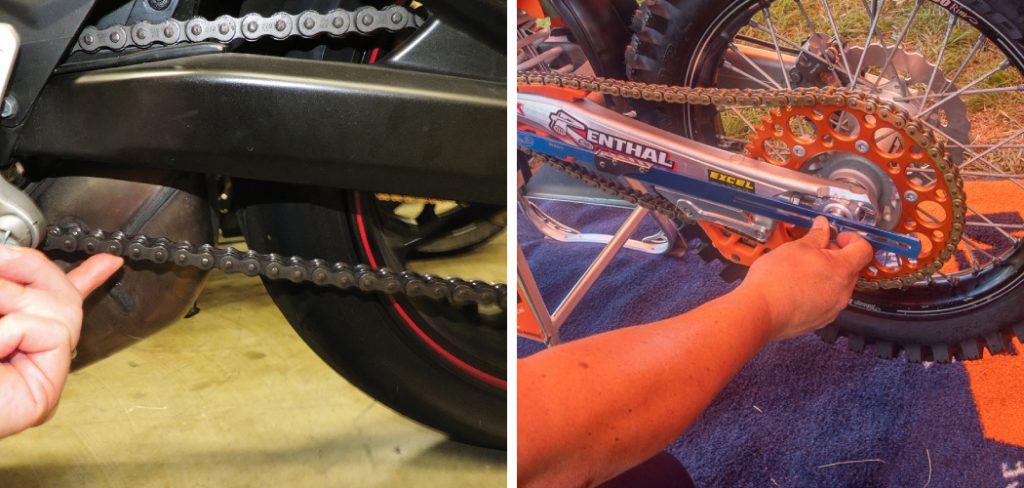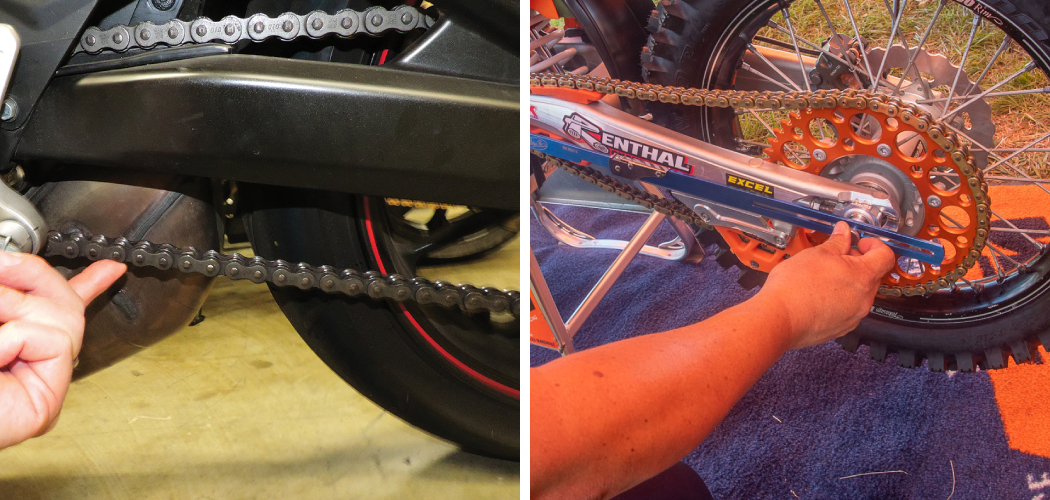A dirt bike chain should be tight, with approximately 1-1.5 inches of slack when the suspension is fully extended and the rider is seated. Maintaining the correct tension is crucial for proper bike performance and preventing excessive wear.
Dirt biking enthusiasts understand the importance of a well-maintained bike, and one crucial aspect is the chain tension. A correctly tightened dirt bike chain ensures optimal power transfer, prevents skipping, and reduces the risk of derailment. But what is the ideal tightness for a dirt bike chain?
We will dive into the specific measurement, helping you understand exactly how tight a dirt bike chain should be. So, if you’re looking to improve your bike’s performance, keep reading to discover the correct tension for your dirt bike chain.

The Importance Of Properly Adjusted Dirt Bike Chains
|
A correctly adjusted dirt bike chain is vital for optimal performance and longevity of your motorcycle. A loose chain can lead to power loss, decreased acceleration, and potential damage to the sprockets and other components. On the other hand, an overly tight chain can cause excessive strain on the engine, leading to premature wear and decreased efficiency. It can also result in added stress on the wheel bearings and suspension system, compromising stability and control. By maintaining the right tension in your dirt bike chain, you can ensure smooth power transmission, enhanced traction, and reduced wear and tear on other vital motorcycle parts. Regularly inspecting and adjusting the chain tension, as recommended by the manufacturer, will help optimize performance and extend the lifespan of your dirt bike. |
Factors That Determine The Ideal Chain Tension
Understanding different types of dirt bike chains Dirt bike chains come in various types, each with its unique characteristics. It is crucial to have a good understanding of the different types of chains available. Common options include heavy-duty, O-ring, X-ring, and standard chains. Each type has its own pros and cons, so it is essential to select the one that best suits your riding style and bike specifications. Considerations for chain slack Recommended chain tension measurements |
Step by Step Guide To Properly Adjust A Dirt Bike Chain
Properly adjusting a dirt bike chain is crucial to ensure optimal performance and prevent damage. To achieve the correct chain tension, you will need a few tools: a socket wrench, a torque wrench, a chain alignment tool, and a ruler or measuring tape.
Follow these step-by-step instructions for chain tension adjustment:
- Start by placing the dirt bike on a stand or lift to lift the rear wheel off the ground.
- Using a socket wrench, loosen the rear axle nut and adjusters on both sides of the swingarm.
- With the chain alignment tool, ensure that the chain sprocket and rear axle are aligned properly.
- Measure the slack in the chain by pressing the top part of the chain upward and downward while keeping the bike in neutral. The ideal chain slack should be around 30-40mm.
- If the chain is too loose, use the adjusters to tighten it evenly on both sides. If it is too tight, loosen the adjusters.
- Once you achieve the desired chain tension, tighten the rear axle nut and adjusters using a torque wrench.
Remember these tips for achieving the correct chain tension:
- Regularly check and adjust the chain tension to maintain optimal performance.
- Ensure the chain is properly lubricated to reduce wear and friction.
- Refer to your dirt bike’s manual for specific chain tension specifications.
Signs Of An Incorrectly Adjusted Chain
Recognizing a loose chain: A loose dirt bike chain can be identified by excessive play or slack. You may notice a rattling noise while riding, or the chain may appear saggy. When manually checking, you should be able to lift the chain off the rear sprocket without much effort.
Identifying a tight chain: On the other hand, a tight dirt bike chain will have little to no play. It may feel tense and rigid. When spinning the rear wheel, you might notice resistance or a squeaking noise. Additionally, the chain may be visibly stretched or strained.
Potential consequences of improper chain tension: Incorrectly adjusted chains can have serious implications on both performance and safety. A loose chain may skip teeth on the sprocket, leading to loss of power or drivetrain damage. In contrast, a tight chain can cause increased wear on the sprocket, chain links, and even the bike’s engine. Proper chain tension is crucial for maintaining smooth and efficient power transfer.
Potential Problems Caused By An Improperly Adjusted Chain
An improperly adjusted dirt bike chain can cause potential problems that affect both performance and safety. One such problem is a loose chain, which can significantly impact the motorcycle’s performance and jeopardize rider safety. A loose chain can lead to slippage and reduced power transfer, resulting in decreased acceleration and overall performance. Additionally, it can affect handling and control, making the bike more difficult to maneuver.
Moreover, a loose chain puts stress on the sprockets and other components, leading to potential damage and costly repairs. On the other hand, having a tight chain can also be problematic, as it creates excessive tension and strain on the drivetrain. This can cause accelerated wear on the chain, sprockets, and other related parts, potentially leading to premature failure. It is crucial to find the right balance and ensure that the dirt bike chain is adjusted correctly, neither too loose nor too tight, for optimal performance and safety.
| Impact of a Loose Chain: |
|---|
| 1. Decreased acceleration and power transfer. |
| 2. Difficulty in maneuvering and control. |
| 3. Increased stress on sprockets and components. |
| 4. Potential damage and costly repairs. |
Having a tight chain is also problematic as it can lead to accelerated wear and premature failure of the drivetrain. It is vital to strike the right balance and ensure the dirt bike chain is adjusted properly, neither too loose nor too tight, to maintain optimal performance and safety.
Regular Maintenance For Dirt Bike Chains
Regular maintenance is crucial to keep your dirt bike chain in optimal condition. Cleaning and lubricating the chain should be part of your routine. **Remove any dirt, debris, and old lubricant from the chain** using a chain cleaner or a brush with a degreaser. Rinse it with water and dry thoroughly. Apply an appropriate chain lubricant **to ensure smooth operation** and prevent rust.
Inspecting the chain regularly is equally important to identify signs of wear and damage. Look for **tight spots, loose rollers, or bent links**. If you notice any of these issues, it’s essential to address them promptly to prevent further damage. **Following a recommended maintenance schedule** will help you maintain the proper tension in your dirt bike chain. Remember, a chain that is too loose can jump off, and one that is too tight can cause excessive wear. It’s crucial to strike the right balance for optimum performance and longevity.
Frequently Asked Questions About Dirt Bike Chain Adjustment
Regularly checking and adjusting the tension of your dirt bike chain is crucial to ensure optimal performance and prevent any unnecessary damage. But how tight should a dirt bike chain be? Let’s address some commonly asked questions about dirt bike chain adjustment.
| What tools are necessary for chain adjustment? |
|---|
| When it comes to chain adjustment, you’ll need a few tools, including a wrench, rear axle nut/spanner, and a torque wrench. These tools will allow you to loosen and tighten the necessary components for proper chain tension. |
| How often should I check and adjust my dirt bike chain? |
| Checking and adjusting your dirt bike chain should be done regularly. It’s recommended to inspect the chain tension every few rides or at least once a month. Keeping your chain properly tensioned will enhance your bike’s performance and prolong its lifespan. |
| Can I adjust the chain tension myself or should I seek professional help? |
| You can certainly adjust the chain tension yourself. With the right tools and following proper guidelines, you can handle chain adjustments with ease. However, if you’re unsure or uncomfortable performing the task, it’s always advisable to seek professional assistance to avoid any potential mistakes. |
Frequently Asked Questions For How Tight Should A Dirt Bike Chain Be
Is A Dirt Bike Chain Supposed To Be Tight?
Yes, a dirt bike chain should be tight to ensure optimal performance and prevent it from slipping off.
How Much Chain Slack On A Dirt Bike?
The ideal chain slack for a dirt bike should be about 1 to 2 inches.
Is It Bad To Ride A Dirtbike With A Loose Chain?
Riding a dirtbike with a loose chain can be risky and lead to damage and accidents.
How Many Fingers Should A Dirt Bike Chain Be?
A dirt bike chain typically has 116 links or 118 pins in total.
Conclusion
Properly maintaining your dirt bike chain is fundamental for optimal performance and longevity. Keeping the chain tension at the right level is crucial to ensure a smooth ride and prevent damage to your bike. Over-tightening the chain can cause unnecessary strain on the engine, while a chain that is too loose increases the risk of it derailing.
So, how tight should a dirt bike chain be? The general rule of thumb is to have around 20-30mm of play in the middle of the chain when measured from the bottom. Remember to check the manufacturer’s guidelines for your specific dirt bike model and make adjustments accordingly.
Regularly inspecting and adjusting your dirt bike chain will not only improve your riding experience but also extend the lifespan of your bike. Stay safe and happy riding!

